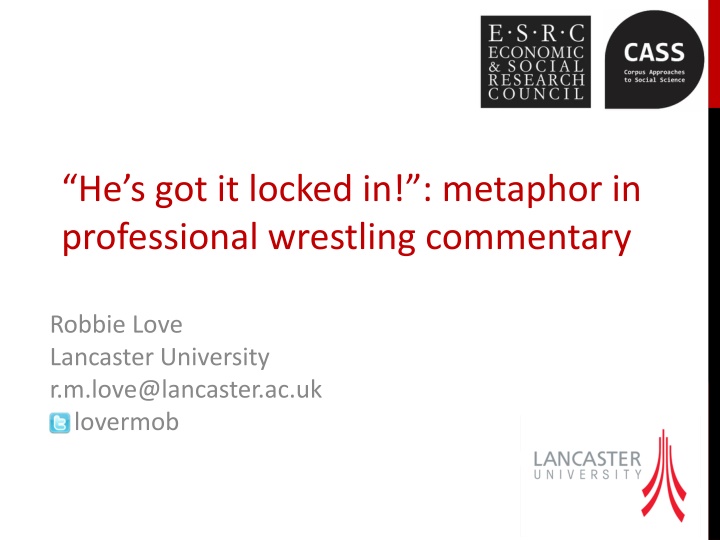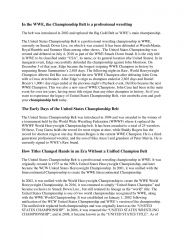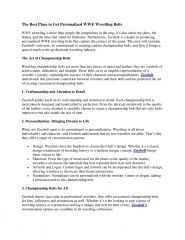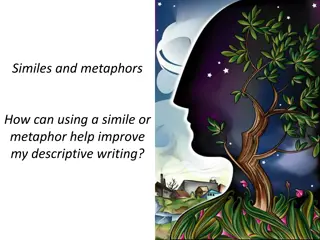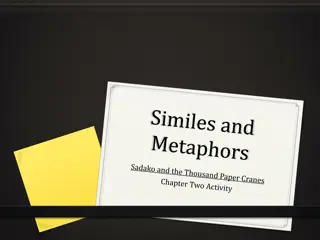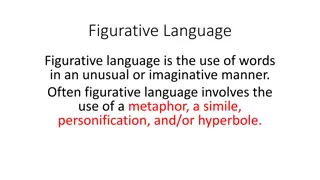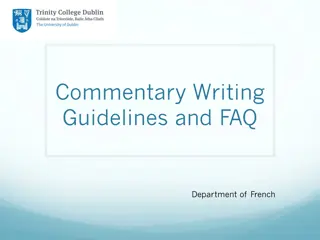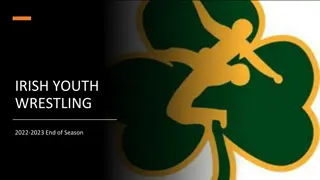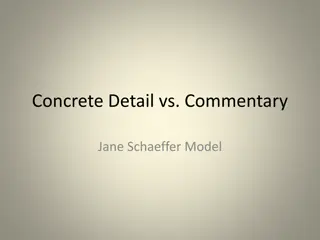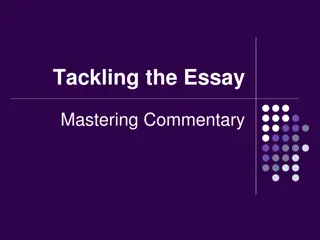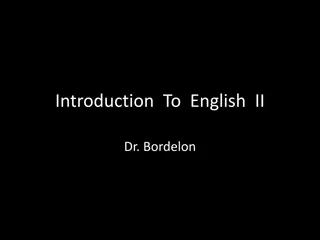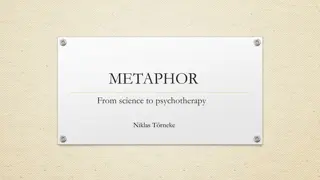The Use of Metaphors in Professional Wrestling Commentary
Metaphor plays a significant role in professional wrestling commentary, shaping how the audience perceives and engages with the sport. This analysis delves into the utilization of linguistic metaphors in the world of professional wrestling and the implications they hold for both the performers and the viewers.
Download Presentation

Please find below an Image/Link to download the presentation.
The content on the website is provided AS IS for your information and personal use only. It may not be sold, licensed, or shared on other websites without obtaining consent from the author.If you encounter any issues during the download, it is possible that the publisher has removed the file from their server.
You are allowed to download the files provided on this website for personal or commercial use, subject to the condition that they are used lawfully. All files are the property of their respective owners.
The content on the website is provided AS IS for your information and personal use only. It may not be sold, licensed, or shared on other websites without obtaining consent from the author.
E N D
Presentation Transcript
Hes got it locked in!: metaphor in professional wrestling commentary Robbie Love Lancaster University r.m.love@lancaster.ac.uk lovermob
Introduction How is metaphor used in professional wrestling commentary? Why might this be interesting? http://cass.lancs.ac.uk
Metaphor the phenomenon whereby we talk and, potentially, think about something in terms of something else (Semino 2008: 1) The fundamentally metaphorical nature of our ordinary conceptual system (Lakoff & Johnson 2003 [1980]: 3) important and ubiquitous in language (Zinken & Musolff 2009: 1) http://cass.lancs.ac.uk
Conceptual Metaphor Theory Conceptual Metaphor Theory (CMT) (Lakoff & Johnson 1980) Real-world concept = target domain The metaphor = source domain Conceptual metaphor = broader cognitive mapping Linguistic metaphor = verbal instantiation of this target source/vehicle http://cass.lancs.ac.uk
Professional wrestling A substantial American popular art form (Sammond 2005: 1) Also Mexico, UK, Japan Performance of competitive physical conflict Its fans know this (Barthes 1957) Televised, with commentary http://cass.lancs.ac.uk
What do we already know? Linguistic analyses of televised sports commentary College basketball: racial/gender stereotyping (Eastman & Billings 2001; Billings et al. 2002); racial bias (Rada & Wulfemeyer 2005) National basketball: racial identity, nationality, and masculinity (Lavelle 2010) No metaphor analysis No pro wrestling analysis http://cass.lancs.ac.uk
What do we already know? Suspense -> enjoyment of televised sports (Peterson & Raney 2008) However, The audience knows it is not legitimate sport Pro wrestling perceived as less suspenseful than sport -> awareness of fiction (Raney & Depalma 2006: 332) Therefore, Pressure to heighten/maintain suspense http://cass.lancs.ac.uk
Research questions To what extent are linguistic metaphors present in professional wrestling commentary? How can they be categorised and attributed to conceptual metaphors? How (if at all) do they contribute to suspense and excitement? http://cass.lancs.ac.uk
Data Commentary of 3 pro wrestling matches 3 commentators World Wrestling Entertainment (WWE) WrestleMania 29 (2013) Orthographic transcription Match Length (mm:ss) Length (words) 1 The Undertaker def. CM Punk 23:02 2,732 2 Triple H def. Brock Lesnar 24:01 3,099 3 John Cena def. The Rock 26:21 2,897 TOTAL 73:24 8,729 http://cass.lancs.ac.uk
Methodological approach Primarily: Metaphor identification procedure (MIP) (Pragglejaz Group 2007) Also influenced by: Discourse dynamics approach (Cameron et al. 2009) Intuition/researcher knowledge relied upon heavily http://cass.lancs.ac.uk
Methodological approach Manual identification of: (Novel and) conventional metaphors vehicle groups Intuition used to filter potential metaphors Then: Frequency-driven analysis (cf. quantitative description , Cameron et al. 2009: 76) Vehicles grouped into abstract conceptual metaphors (traditional CMT, Semino 2008) http://cass.lancs.ac.uk
Analysis 780 linguistic metaphors = 8.94% 331 novel conceptual metaphors names of characters and the signature moves they perform foregrounding aspects of character to assist goodie / baddie portrayal E.g. WRESTLERS ARE INHUMAN E.g. WRESTLING MOVES ARE NATURAL PHENOMENA E.g. WRESTLERS ARE NOT WRESTLERS http://cass.lancs.ac.uk
Conventional metaphors 449 conventional main focus today instantiate shared conceptualisations of the target domains among speakers (Semino 2008: 226) less readily noticeable as metaphors spontaneously produced, on-the-fly commentary (1) WRESTLING IS A SERIES OF SHORT JOURNEYS (2) WRESTLERS ARE CONTAINERS (3) WRESTLING MOVES ARE CONTAINERS (4) WRESTLING IS WAR http://cass.lancs.ac.uk
Conventional metaphors Vehicle domain Freq. % 1 MOVEMENT 101 17.35 2 CONCRETISING 100 17.18 3 WAR 55 9.45 4 VIOLENT ACTION 54 9.28 5 LOCATION 46 7.90 6 NONHUMAN 26 4.47 7 LIFE/DEATH 20 3.44 8 VISION 17 2.92 9 FINANCE/ECONOMY 15 2.58 10 GAME 15 2.58 Total 449 77.15 http://cass.lancs.ac.uk
(1) WRESTLING IS A SERIES OF SHORT JOURNEYS Evoked by MOVEMENT vehicle domain Split further into GOAL and PATH domains (Cameron et al. 2009: 75) GOAL = performance of signature move go/going/went for (19) PATH = the course of the match i.e. dominance back and forth (4), bounced (back), turned http://cass.lancs.ac.uk
(1) WRESTLING IS A SERIES OF SHORT JOURNEYS GOAL = performance of signature move Shawn tried to go for Sweet Chin Music instead (Jerry Lawler, Triple H vs. Brock Lesnar) PATH = the course of the match i.e. dominance this is back and forthbut we ve seen this before . just when the Game thinks he s building momentum he just can t keep it (Jerry Lawler, Triple H vs. Brock Lesnar) http://cass.lancs.ac.uk
(2) WRESTLERS ARE CONTAINERS Evoked by CONCRETISING vehicle domain; specifically the vehicle groups POSSESSION (14) and CAPACITY (10) POSSESSION the Rock has him . the Rock has him. the Rock s got him. he s done it twice (John Bradshaw Layfield, The Rock vs. John Cena) and Triple H . has got him again (Michael Cole, Triple H vs. Brock Lesnar) http://cass.lancs.ac.uk
(2) WRESTLERS ARE CONTAINERS Evoked by CONCRETISING vehicle domain; specifically the vehicle groups POSSESSION (14) and CAPACITY (10) CAPACITY it s almost like these two superstars are back to square one . they ve given it their all (Jerry Lawler, The Undertaker vs. CM Punk) uh oh . still some fight left in the Game (Jerry Lawler, Triple H vs. Brock Lesnar) http://cass.lancs.ac.uk
(3) WRESTLING MOVES ARE CONTAINERS Evoked by CONCRETISING vehicle domain; specifically the vehicle groups POSSESSION (14) and LOCK (11) POSSESSION he caught him with the Go To Sleep . Undertaker into the Tombstone (Michael Cole, The Undertaker vs. CM Punk) and he caught him with the Tombstone (Jerry Lawler, The Undertaker vs. CM Punk) http://cass.lancs.ac.uk
(3) WRESTLING MOVES ARE CONTAINERS Evoked by CONCRETISING vehicle domain; specifically the vehicle groups POSSESSION (14) and LOCK (11) LOCK and look . sleeper hold by the Rock . sleeper hold . Cena . trying to reverse . yeah but Rock has it locked in now . Cena s in the centre of the ring (Michael Cole, The Rock vs. John Cena) referee checking the shoulders . Punk with the Vice locked in . here s the two count . and Undertaker has to power up at two . look at this (Michael Cole, The Undertaker vs. CM Punk) http://cass.lancs.ac.uk
(4) WRESTLING IS WAR Evoked by the WAR vehicle group (55 examples) Vehicles include: striker, shots, exploded, fire, command, fighting machine, destroyer, bombs, battle, unloading and war itself http://cass.lancs.ac.uk
(4) WRESTLING IS WAR as Rock explodedout of the corner . there s Cena with the flying tackle (Michael Cole, The Rock vs. John Cena) these guys are throwing bombs at each other (John Bradshaw Layfield, The Undertaker vs. CM Punk) it is a war . Triple H with that sledgehammer in hand but he was caught (Jerry Lawler, Triple H vs. Brock Lesnar) http://cass.lancs.ac.uk
Conclusion To what extent are linguistic metaphors present in professional wrestling commentary? The language of pro wrestling commentary is extensively conceptualised (Bergh 2011: 87) in terms of metaphor http://cass.lancs.ac.uk
Conclusion How can they be categorised and attributed to conceptual metaphors? (1) WRESTLING IS A SERIES OF SHORT JOURNEYS (2) WRESTLERS ARE CONTAINERS (3) WRESTLING MOVES ARE CONTAINERS (4) WRESTLING IS WAR http://cass.lancs.ac.uk
Conclusion How (if at all) do they contribute to suspense and excitement? Short-term success goals of the characters The rapidly-changing narrative of the match Dominance, determination, and vulnerability Physical conflict heightened Metaphors as aids for the suspension of disbelief http://cass.lancs.ac.uk
What next? (How) does this differ to legitimate sports commentary? Explore researcher knowledge could an outsider to wrestling replicate these results? Does this matter? Diachronic analysis Corpus approach there is certainly enough content if someone can transcribe it! How could such knowledge help pro wrestling companies enhance what they do? http://cass.lancs.ac.uk
Selected references Barthes, R. (1957). The World of Wrestling. In Sammond, N. (ed.) (2005). Steel Chair to the Head: The Pleasure and Pain of Professional Wrestling. Durham, NC: Duke University Press. Pp. 23-32. Bergh, G. (2011). Football is war: A case study of minute-by-minute football commentary. Revisita Revedas, 15(2). 83-93. Retrieved from http://www.ufjf.br/revistaveredas/files/2011/05/artigo-72.pdf Billings, A.C., Halone, K.K. & Denham, B.E. (2002). Man, That Was a Pretty Shot : An Analysis of Gendered Broadcast Commentary Surrounding the 2000 Men s and Women s NCAA Final Four Basketball Championships. Mass Communication and Society, 5(3). 295-315. doi:10.1207/S15327825MCS0503_4 Cameron, L., Maslen, R., Todd, Z., Maule, J., Stratton, P. & Stanley, N. (2009) The Discourse Dynamics Approach to Metaphor and Metaphor-Led Discourse Analysis. Metaphor and Symbol, 24. 63-89. doi:10.1080/10926480902830821 Eastman, S.T. & Billings, A.C. (2001). Biased Voices of Sports: Racial and Gender Stereotyping in College Basketball Announcing. Howard Journal of Communications, 12(4). 183-201. doi:10.1080/106461701753287714 Gray, R. (2013). Part 2 of the JBL and Cole Show s Halloween Special. Retrieved 12 November 2013, from Wrestling News World website, http://www.wrestlingnewsworld.com/part-2-of-the-jbl-cole-shows-halloween-special/#prettyPhoto Lakoff, G. & Johnson, M. (2003 [1980]) Metaphors we live by (2nd ed.). Chicago: University of Chicago Press. Lavelle, K.L. (2010). A Critical Discourse Analysis of Black Masculinity in NBA Game Commentary. Howard Journal of Communications, 21(3). 294-314. doi:10.1080/10646175.2010.496675 Mazer, S. (1998). Real Wrestling / Real Life. In Sammond, N. (ed.) (2005). Steel Chair to the Head: The Pleasure and Pain of Professional Wrestling. Durham, NC: Duke University Press. Pp. 67-87. Peterson, E.M. & Raney, A.A. (2008). Reconceptualizing and Reexamining Suspense as a Predictor of Mediated Sports Enjoyment. Journal of Broadcasting & Electronic Media, 52(4). 544-562. doi:10.1080/08838150802437263 Pragglejaz Group. (2007). MIP: A method for identifying metaphorically used words in discourse. Metaphor and Symbol, 22(1), 1-39. Retrieved from http://www.academia.edu/235704/MIP_A_method_for_identifying_metaphorically_used_words_in_discourse Rada, J.A. & Wulfemeyer, K.T. (2005). Color Coded: Racial Descriptors in Television Coverage of Intercollegiate Sports. Journal of Broadcasting & Electronic Media, 49(1). 65-85. doi: 10.1207/s15506878jobem4901_5 Raney, A.A. & Depalma, A.J. (2006) The Effect of Viewing Varying Levels and Contexts of Violent Sports Programming on Enjoyment, Mood and Perceived Violence. Mass Communication and Society, 9(3). 321-338. doi:10.1207/s15327825mcs0903_4 Sammond, N. (2005). Introduction: A Brief and Unnecessary Defence of Professional Wrestling. In Sammond, N. (ed.). Steel Chair to the Head: The Pleasure and Pain of Professional Wrestling. Durham, NC: Duke University Press. Pp. 1-21. Semino, E. (2008). Metaphor in Discourse. Cambridge: Cambridge University Press. Tamborini, R., Skalski, P., Lachlan, K., Westerman, D., Davis, J. & Smith, S.L. (2005). The raw nature of televised professional wrestling: Is the violence a cause for concern? Journal of Broadcast & Electronic Media, 49(2), 202-220. doi:10.1207/s15506878jobem4902_4 Zinken, J. & Musolff, A. (2009). Metaphor and Discourse. Basingstoke: Palgrave Macmillan. doi:10.1057/9780230594647 http://cass.lancs.ac.uk
